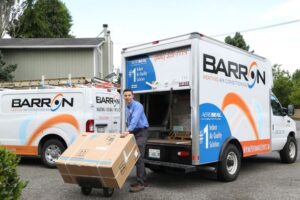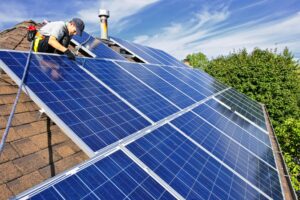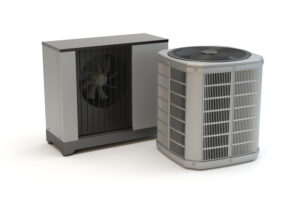Solar cuts your ongoing electrical costs, heat pumps lower your energy bills, and they can work together to compound those effects. When you power your heat pump with solar energy, you’re supercharging your home sustainability, and this is why it works.
Barron Heating AC Electrical & Plumbing Blog: Archive for the ‘Heat Pumps’ Category
Home Sustainability: How Solar Panels and Heat Pumps Work Together
Monday, December 4th, 2023Daikin FIT Enhanced – Qualifies for the 25c Tax Credit
Monday, October 2nd, 2023Homeowners like yourself are always on the lookout for major home savings in any capacity that they can receive. The 25c Tax Credit is exactly what you’re looking for, and with Daikin, you can take full advantage of it.
Daikin’s FIT Enhanced heat pump comes with numerous benefits, but we’re not talking about product features here–we’re talking about serious savings with the 25c tax credit that began in 2023.
Heat Pumps: How They Heat and Cool Your Home
Monday, February 13th, 2023Heat pumps are the highly energy-efficient alternative to central air conditioning, boilers, and gas furnaces. But do they actually replace all of those different HVAC units at once?
Yes and no. There are some operating restrictions, such as extreme temperatures, but heat pumps really can do the job of both a furnace and air conditioner.
They work differently than you’d expect. Let’s start right from the beginning.
Heat Pumps Transfer from Sources
There are two types of heat pumps. The first one is air source heat pumps, which move air from inside your home to the outside of your home. They don’t actually generate new heat; they move or “pump” it from one area to another.
Then you have ground source heat pumps, sometimes referenced as geothermal heat pumps. These use a closed loop system that’s either filled with water or refrigerant. It moves through pipes that go into the ground outside.
When it’s cold out, water or refrigerant actually heats up as it travels through the underground pipe. When it comes back to the surface, the heat that it generates is then pumped into your home.
They’re Also Air Conditioners
Take that as literally as you want–heat pumps have identical functions to air conditioners. They use refrigerant and pull hot air from inside your home, releasing it outdoors, and pushing cool air into your living space.
There’s no distinct difference in the operational capabilities of heat pumps over air conditioners for cooling your home. Both are effective solutions, but only one doubles as a heater.
We Need to Talk About Efficiency
Heat pumps are extremely energy efficient, but this changes based on the temperature. In extreme cold, heat pumps have a hard time because they’re not actually generating new heat.
The amount of energy your heat pump will use to heat your home increases as the outside temperature drops. In most climates in the US, heat pumps will work effectively and extreme ranges shouldn’t be a major issue if you’re considering switching to a heat pump.
Our team of Home Performance Experts has served the I-5 corridor from Blaine to Marysville, Oak Harbor to Concrete, and the San Juan Islands since 1972 with a mission of Improving Lives™. We look forward to serving you too! Contact Barron Heating & Air Conditioning today for heat pump installation.
Considering a New Heat Pump System?
Monday, June 14th, 2021
For many homeowners in the market for a new cooling system, a heat pump is the perfect option. These systems are highly versatile, providing around-the-clock comfort, greater opportunity for indoor air quality, and substantial savings in your energy bill. The question is, is a heat pump the right choice for your home’s cooling needs?
Below, we’ve covered many of the common benefits of these systems, and we hope that if you have any questions about making a switch from a more traditional system, you’ll reach out to our Home Performance Experts! Heat pumps are fantastic investments that provide homeowners with lower monthly utility payments, and more. Read on!
Understanding Heat Pump Efficiency
Tuesday, July 23rd, 2013Heat pumps can be much more efficiency than other systems. Here in the Northwest, a heat pump can have an efficiency starting at 300%, while electric heating systems have an efficiency of 100%. Oil heat systems range in efficiency from 50% to 85%. Natural gas systems range in efficiency from 50% to 95%.

The efficiency of a heat pump is indicated by Coefficient of Performance or COP. The COP is the ratio of what you get in heat energy from the heat pump divided by what you pay for in electric energy to provide that heat. For example, a COP of 3.0 means for every dollar’s worth of heat delivered to your home, you only need to buy $0.33 worth of electricity. With standard heat pumps, as the outdoor temperature decreases, the efficiency and COP of a heat pump decreases. When the outdoor air temperature is 47 degrees, many heat pumps work with COPs in the range of 3 to 3.8. At 17 degrees, COPs are typically 2.8 to 3.4. The higher the COP, the more efficient the heat pump.
In the Pacific NW, a properly sized and well-installed heat pump will have an average COP of 2.75 over the course of a heating season. (Based on Base Model Efficiency)
There are other factors which reduce the efficiency of a heat pump throughout the heating season. For instance, a heat pump’s outdoor coils periodically need to be defrosted. This is done by reversing the cycle of the heat pump so that the heat from the house thaws the ice accumulated on the coils.
Efficiency is further reduced whenever the back-up heating system is used. This back-up system can be electric, natural gas or oil and is required during times when the outside temperature is so low that the heat pump is not able to provide enough heat for the house. This is called the balance point.
Heat pumps are also rated by a measurement call the Heating Seasonal Performance Factor (HSPF), which estimates the heat output relative to the energy consumed for the entire heating season. The higher the HSPF the less energy you will need to operate the heat pump. An HSPF of 8 corresponds approximately to an average COP of 3.
Posted by Wes Diskin
‘Right Sizing’ Heat Pumps for the Pacific Northwest
Friday, July 12th, 2013Sizing is one of the most important factors determining a heat pump’s efficiency and reliability. In Western Washington, heat pumps are sized according to the heating requirements of your home. If you lived in a climate where heat pumps are primarily used for air conditioning, then you homes cooling needs would determine the size of the heat pump.
In order to determine size, we must do a heat loss for your home as well as analyse your home’s duct sizing to determine air circulation requirements. For a proper installation these calculations must be done. This helps us “balance” the system to ensure that the heat pump delivers the correct amount of air to all rooms in the house.
Heat pumps are sized in two ways; tone and BTUs. Tons do not refer to the weight of the heat but rather are a measure of cooling capacity. Each ton of heat pump capacity produces about 12,000 BTUs of heat. A BTU is a measure of heat output; most heat pumps are in the 24,000 to 60,000 BTU range or 2 to 5 ton range.
As the temperature outside drops, the ability of most heat pump systems (except inverter) to deliver heat also drops somewhat and the heat needs of the house go up. It is possible to install a system large enough to heat the house no matter how low the temperature is outside. But a system which is sized to heat your home during the coldest day of the year will be over sized the rest of the year. This is not only uneconomical, but also places unnecessary stress on the compressor because the heat pump cycles on and off constantly.
In the Pacific NW’s maritime climate, a heat pump should be sized so that it can heat the house when outside temperatures are as low as 30 degrees, below that you will need to invest in a 2-stage or Modulating Heat Pump.
Posted by Wes Diskin
All About Ductless – An Overview
Friday, May 3rd, 2013Save Energy & Money
A Ductless Heat Pump is a highly efficient heating and cooling system that is easily installed as a new primary heat source for electrically heated homes. Ductless systems heat and cool homes at a fraction of the cost of baseboards and wall heaters.
More Comfortable.
Ductless systems do a better job of distributing warm or cool air around a home, thus making your living areas more comfortable. They are especially well suited to homes with open floor plans, as one indoor unit can heat/cool a large living space quite well.
Easy to Install.
The ductless system design allows you to retain the original aesthetics of a room. They do not require expensive and invasive ductwork; they require only a three-inch opening in the wall or ceiling. Installation is as simple as mounting the indoor and outdoor units, connecting the refrigerant lines, and making a few electrical connections. Most installations can be done in a day or two.
APPLICATIONS
Ductless Heating and Cooling systems can be used to heat and cool a wide variety of spaces. Here are a few popular residential applications:
- Homes with Electric Heat – Ductless systems can replace or supplement inefficient existing electric baseboard/wall/ceiling units, woodstoves and other space heaters (propane, kerosene). A cost effective electric heat conversion in a small house might consist of a Ductless system serving the main area of the house, while leaving existing electric baseboards in bedrooms and bathrooms for supplementary heat when needed.
- Remodels and Room Additions – A Ductless system can be used when a room is added to a house or an attic is converted to living space. Rather than extending the home’s existing ductwork or pipes or adding electric resistance heaters, the ductless heat pump can provide efficient heating and cooling.
- New Construction – New homes can be designed or adapted to take advantage of the characteristics of ductless heat pumps. One or more systems might be installed in various “zones” of the house to simplify installation and minimize refrigerant line length.
PROVEN TECHNOLOGY
Ductless systems have been around for several decades and are manufactured by many of the companies you’re used to buying products from. You can rest assured that your investment is in a proven technology that you will be happy with for many years to come.
Posted by Wes Diskin



